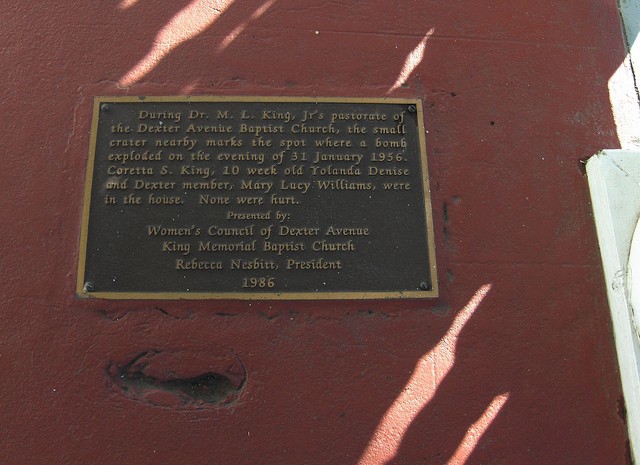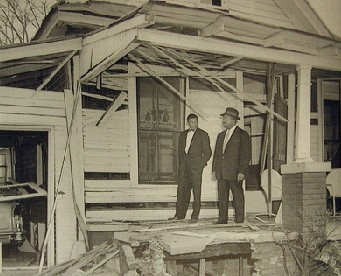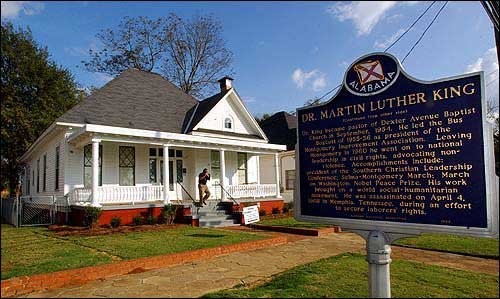Dexter Parsonage Museum
Introduction
Text-to-speech Audio
This small museum is located in the parsonage that was home to Martin Luther King Jr. and Vernon Johns. During his early tenure in Montgomery, King and his family lived at this home prior to the start of the Montgomery Bus Boycott. The home was also repeatedly bombed by white supremacists during the years of King's leadership of the Montgomery Bus Boycott. The home today is open to the public to view historical exhibits related to Vernon Johns, Martin Luther King, Jr. and other African Americans in Montgomery.
Images
A plaque and the leftover damage from one of the bombs after reconstruction.

King on his porch after the initial blast and right before his speech to calm his neighbors from attacking the police officers.

The exterior of the house and a plaque commemorating it.

King and his wife and daughter, Coretta and Yolanda at the doorway of their home upon first moving in in 1954

Backstory and Context
Text-to-speech Audio
Dr. Vernon Johns was an influential civil rights leader who presided over the Dexter Avenue Baptist Church from 1947-1952. While he is often viewed as Martin Luther King's predecessor, King referred to himself as being Johns' successor. Vernon Johns was more radical than King in his early years, an advocate of self-defense and a champion for Black-owned business. Johns was so active and outspoken that the congregation voted to remove their leader for fear of angering white leaders in the city. In 1950, Johns led a boycott of the city buses after refusing to accept segregation.
Martin Luther King Jr. served as the minister at Dexter Avenue Baptist Church from 1954 to 1960 and also lived at this home. After the arrest of Rosa Parks in 1955, King was asked to lend his church to activists so that they could have a meeting to discuss a possible boycott of the city bus system. King was asked to lead the boycott which was organized by many of the women of the city. The boycott lasted 381 days as Black women and men financially crippled the municipal bus system. The police chief publicly supported a white supremacist group, emboldening terrorists to bomb the parsonage during the early weeks of the boycott. The house was bombed one more time in 1957. All seven perpetrators were eventually caught, but all were acquitted by a jury.
The home is dedicated to King and Johns and other ministers of the church. The house is made to appear much as it would have when the King family lived in the home. In addition to exhibits and artifacts, visitors can still view some of the damage from the bombings of this home.
Martin Luther King Jr. served as the minister at Dexter Avenue Baptist Church from 1954 to 1960 and also lived at this home. After the arrest of Rosa Parks in 1955, King was asked to lend his church to activists so that they could have a meeting to discuss a possible boycott of the city bus system. King was asked to lead the boycott which was organized by many of the women of the city. The boycott lasted 381 days as Black women and men financially crippled the municipal bus system. The police chief publicly supported a white supremacist group, emboldening terrorists to bomb the parsonage during the early weeks of the boycott. The house was bombed one more time in 1957. All seven perpetrators were eventually caught, but all were acquitted by a jury.
The home is dedicated to King and Johns and other ministers of the church. The house is made to appear much as it would have when the King family lived in the home. In addition to exhibits and artifacts, visitors can still view some of the damage from the bombings of this home.
Sources
Duhigg, Charles. The Power of Habit. New York City, New York. Random House Trade Paperbacks, 2014.
Luker, Ralph E.. Johns the Baptist. Ralph Luker. Accessed December 09, 2017. http://www.ralphluker.com/vjohns/baptist.html.
Curry, Dodson M. Minister's Home / Dr. Martin Luther King. HMdb- The Historical Marker Database. March 04, 2010. Accessed December 09, 2017. https://www.hmdb.org/marker.asp?marker=86132.
Burns, Sarah F.. MARTIN LUTHER KING JR’S PARSONAGE HOME IN MONTGOMERY, ALABAMA. House Crazy. April 05, 2013. Accessed December 09, 2017. http://www.house-crazy.com/martin-luther-king-jrs-parsonage-home-in-montgomery-alabama/.
Luker, Ralph E.. Johns the Baptist. Ralph Luker. Accessed December 09, 2017. http://www.ralphluker.com/vjohns/baptist.html.
Curry, Dodson M. Minister's Home / Dr. Martin Luther King. HMdb- The Historical Marker Database. March 04, 2010. Accessed December 09, 2017. https://www.hmdb.org/marker.asp?marker=86132.
Burns, Sarah F.. MARTIN LUTHER KING JR’S PARSONAGE HOME IN MONTGOMERY, ALABAMA. House Crazy. April 05, 2013. Accessed December 09, 2017. http://www.house-crazy.com/martin-luther-king-jrs-parsonage-home-in-montgomery-alabama/.
